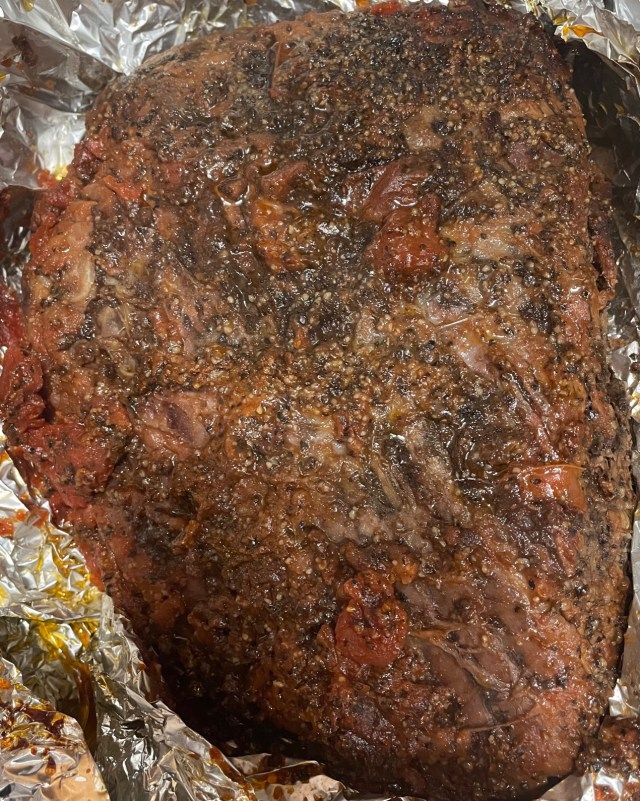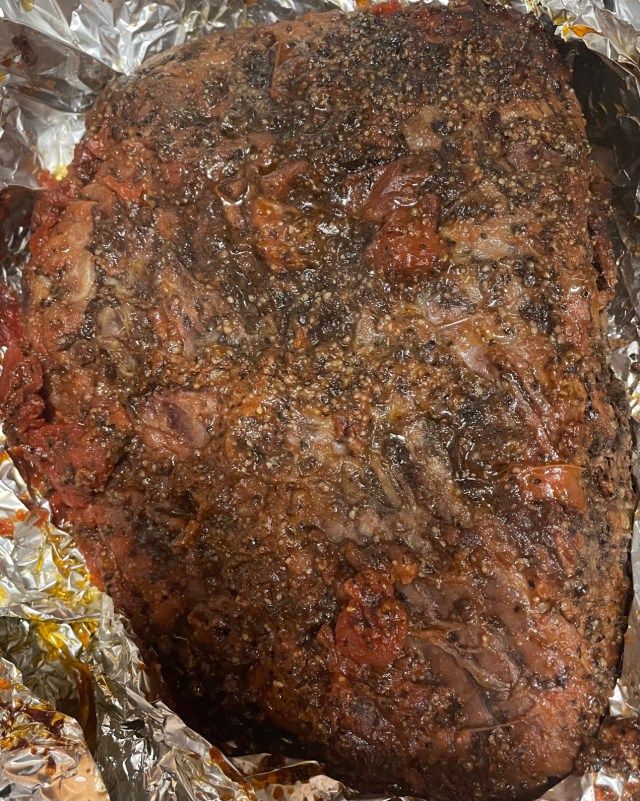Smoked Brisket Experiment

Here are my notes based on smoking a brisket in my Masterbuilt electric smoker. It’s been a while since I’ve had brisket, but I need to come up with a process to prepare for my Master BBQ certification class.
I’ve been researching online and using some books that I have to see which processes have worked best from some of the best BBQers in the industry.
Here are some questions that I’ve had during my reading and my thinking.
1. What kind of rub? This is a personal preference but many professionals like a simple Dalmatian rub (salt/pepper) since they don’t want to take away too much from the taste of the beef. My process is sort of in the middle. I used various types of pepper, sugar, paprika, chili, and cumin. Most of the peppery/smokiness flavor goes well with beef. I was thinking the sugar would even out the other flavors and provide a little bit of contrast. I didn’t use salt. See item #4 below for my reasoning.
2. To wrap or not to wrap. The Texas Crutch is commonly used to speed up the cooking process and help retain moisture. Once the brisket reaches between 165-170 degrees, wrap the brisket in either aluminum foil or butcher’s paper. You may want to add some beef stock during this time as well. One of the downsides to the Texas Crutch method (supposedly) is that is softens the bark. Again, this is a matter of personal preference. I don’t mind the bark (rub) being soft and like the meat more moist but I also don’t want the bark to be so soft that it falls off the meat.
3. Flat or point. I’m just going to keep it simple (you can research the differences on Google) for now but the flat is the piece of meat that is a compromise between meat that is too fatty but it can also be a little dry. The point is fattier and moist but sometimes it is too fatty. I try to find the middle ground by making a moist flat. Ideally, if my smoker was larger, I would get a Packer’s Cut which has both the flat and point.
4. To brine or not. I think a wet brine would steam the meat too much and is messy. If I’m going to brine, I would rather do a dry brine. Common practice seems to be about 1/2 teaspoon of Kosher salt per pound of meat and leave it on for at least a few hours (up to 24). Since I’m dry-brining, I don’t put any more salt in my rub.
5. Slather the meat or not? What kind of slather? The slather is the binder that is used to help the rub stay on the meat. For pork, I always use mustard. Since I haven’t made brisket recently, I am still deciding if I will do mustard or something else. For this first experiment, I used tomato sauce with a little paste and vinegar. According to amazingribs.com, the taste of the slather doesn’t typically last long into the cooking process. I was thinking it would help more with the moisture.
6. Injection. I didn’t do injection for my first experiment but may be open to it for next time. I sometimes think it is a little messy/cumbersome.
7. Water pan filled in smoker or not? I fill the water pan one time. I am undecided on whether I should open up the smoker too much during cooking to refill the pan or not. For the first time I did this, I only did the initial fill.
Here is what I did for my first attempt
Ingredients
Rub
3 Tablespoons Black Pepper
3 Tablespoons Brown Sugar
1 Tablespoon of Paprika
1 Tablespoon of Chili Powder
1 Teaspoon of Cumin
(Depending on the amount of meat, you can double, triple this recipe)
Approximately 8 Pounds of Brisket Flat
4 Teaspoons of Kosher Salt
16 Ounce Can of Tomato Sauce (Unflavored)
6 Ounce Can of Tomato Paste
A little vinegar (maybe 1/4 cup)
Technique
This was done in a smoker but can easily be adjusted to oven cooking.
1. Remove the meat from the Cryovac pack. You may want to read the label to make sure the meat was not pre-brined. If it was, you shouldn’t brine it again.
2. Wash off the meat and dry it.
3. Trim all but a little bit of the fat (1/8 to 1/4 inch of fat). Remove any hard fat and silver skin (if there).
4. Apply salt to outside of brisket for dry brine. Tightly wrap in press-n-seal or plastic wrap.
5. Let sit in fridge for a few hours (up to 24).
6. Mix tomato sauce, paste, and vinegar in bowl.
7. Apply this slather to the outside of the meat. Apply the rub. I didn’t go as heavy on the rub as I did with the pulled pork. Maybe only a single layer on all of the meat is appropriate.
8. I cut the brisket flat in half. Approximately 4 pounds each. I placed each of these in a disposable aluminum pan (uncovered).
9. Preheat the smoker to 225. Once preheated, add the meat and put a little bit of wood in smoker. Depending on the amount of smokiness you desire, add a few loads over the first hour or two. Anything added after that, will not contribute to flavor of meat. Insert meat thermometer into thickest parts of meat.
10. I filled up the water pan with some hot water.
11. I put the beef in the smoker around 9PM. Within a few hours, the beef was at approximately 140-150 degrees.
12. When both pieces of beef reached approximately 170 degrees (around 3AM), I tightly wrapped the beef with aluminum foil to do the Texas Crutch.
13. One piece of beef was finished around 6AM. The other piece didn’t finish until around 9AM-10AM. Not sure why there was a difference. Maybe fat content was a little different on the two pieces.
14. I let the beef sit out approximately 1 hour after cooking and then sliced it.
The bark held to the meat nicely and imparted a good flavor. The only downside (in my opinion) was that the meat was not as moist as I would like. This could either be due to the cut (flat), too much trimming of fat, and/or not enough juices/moisture.
Some Potential Improvements
1. Next time, I may add some stock to the foil or even more stock to the pan halfway through the cooking time to keep the meat moist (not too much). Alternatively, I could keep more water in the water pan. I want to find the right balance between having too much liquid (steaming the meat) and just keeping it moist.
2. I may also try using mustard for the slather the next time.
